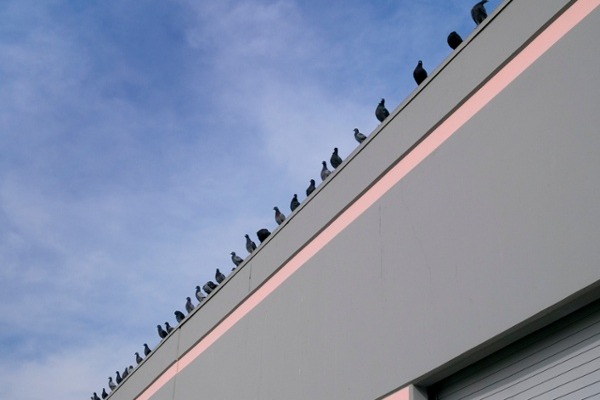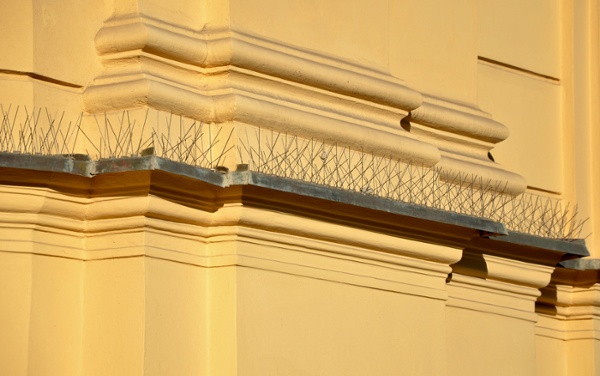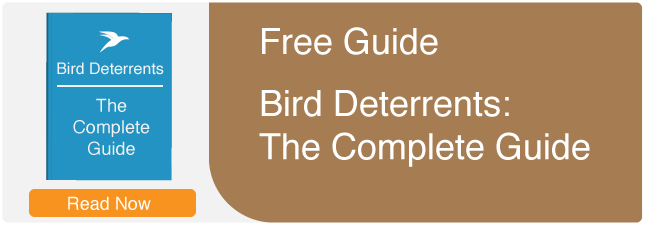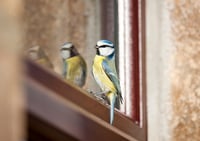
Birds can create a variety of issues inside and outside of commercial structures. For business owners investing in professional bird control measures, finding the right technique is crucial. Whether birds are nesting in signage, defacing your building, or invading a warehouse, the damage to commercial buildings from pest birds can be costly. Early bird deterrent methods can help, but frightening birds away from large commercial properties can be difficult. Perimeter defenses in bird control are often the tools that can help you protect your commercial building.
How Birds Damage Commercial Buildings
Business owners have long suffered from the issues caused by pest bird flocks. Bird droppings are typically considered the most offensive since they create unpleasant odors, create slippery areas in parking lots and on sidewalks, and damage building surfaces. As business owners and consumers have learned more about the many diseases that can be spread through bird droppings, keeping pest birds away is more important than ever.
However, for many business owners, messy droppings aren't the only reason to seek bird control. Consider these additional ways pest birds damage commercial property:
- • Damage to HVAC systems from nesting habits
- • Roof damage from roosting or nesting birds
- • Aggressive parent birds targeting customers
- • Damage to gutters from nesting habits
- • Sagging ceilings due to excessive droppings from birds nesting within the ceiling
- • Insect infestations from nesting materials and extreme bird infestations
- • Blocked ventilation systems from nesting materials
- • Fire damage from built-up nesting materials
- • Damaged inventory from birds that gain entry into buildings and warehouses
- • Water damage from a leaking roof damaged by birds
Any combination of these issues can mean big financial losses for your business, so it's essential to be proactive about bird control. For most large commercial properties, effectively managing bird control requires the creation of boundaries that birds can't penetrate. Perimeter defenses in bird control are tools that prevent birds from accessing certain areas inside and outside of your commercial building.
What Are Perimeter Defenses?

There are a variety of tools used in professional bird control to effectively help homeowners and businesses avoid pest bird infestations and the damage that comes along with them. While tools that frighten birds away are effective in low bird pressure situations, commercial properties often need bird control measures that create physical barriers for birds.
Perimeter defenses in bird control are the tools that create a physical obstacle to prevent birds from accessing a certain area. Instead of attempting to convince birds that the area isn't safe, these methods block an attractive nesting area or entry point. In the same way you might erect a fence to keep animals from accessing your garden, there are a variety of methods that keep pest birds from accessing your commercial property.
Some common examples of perimeter defenses in bird control include:
• Bird Netting
• Solar Panel Exclusionscoil
• Bird Spikes
• Bird Slides
• Vent Guards
• Gridwire
• Birdwire
• Bird-Coil
How Perimeter Defenses in Bird Control Work
There are a variety of reasons birds choose certain areas to nest and roost. Access to food and water is one of the biggest reasons birds hang around commercial properties. Safety from natural predators is the other main reason that birds target any property. When birds can find safe nesting and roosting areas with a continuous food source, it can be very difficult to convince them to leave.
As a business owner, it's your responsibility to take care of your commercial property in a way that helps avoid bird infestation. After all, pest birds can be a danger to your customers and employees. Their unsanitary nature can also mean guests won't want to visit your property. In any situation that involves pest birds, it's important to begin with preventive measures that make your commercial property less habitable.
Use these methods to avoid attracting birds to your property:
- • Avoid leaving food (including animal food) outside where birds have access.
- • Eliminate containers that hold standing water.
- • Keep outdoor trash cans tightly covered.
- • Place signs around the property to discourage visitors from feeding birds.
If you've taken all the preventative measures listed, and you still have flocks of birds invading your property, then you'll likely need to utilize tools that make your commercial property less attractive as a roosting or nesting spot for pest birds. Perimeter defenses are made up of both bird deterrents and exclusion products. Each of these tools works in a different way to achieve the same goal. Commercial buildings offer a variety of hard-to-reach nesting spots. So a combination of tools is often needed for success in eliminating bird infestations.
Perimeter defense in bird control works in one of these three ways:
1. Ledge Destabilization
Your commercial building provides birds with an excellent view of incoming predators. Ledges typically provide a solid foundation for birds to land on and roost for long periods of time. But a variety of products exist that make ledges, railings, and pipes unstable for birds to use. For instance, bird spikes create a spiky surface that most birds can't roost on. Bird-Coil works in a similar way with coils of nearly invisible wire that eliminates the solid surface provided by building ledges. Bird slides make ledges and other flat surfaces angled so all species of birds will slide right off when attempting to roost.
2. Entryway Exclusion
Birds can easily enter buildings and warehouses through large doors and loading docks. They also find access to outdoor spaces where they can cause expensive damage. The most common entryway exclusion technique is bird netting which completely blocks the entry of birds. Bird netting may be used on large doors or other openings. It's also commonly used to protect neon signs and loft areas that birds attempt to access for nesting purposes. Other types of entryway exclusion devices prevent birds from accessing attractive nesting spots like vents, solar panels, and HVAC equipment.
3. Protection for Open Spaces
Protecting large, open outdoor spaces from birds can seem like an impossible feat. Luckily, there are also ways to create perimeters around these areas. Gridwire can be positioned in horizontal and vertical positions to protect large spaces — like warehouse roofs, parking lots, lakes, and other open spaces — from large pest birds.
Perimeter defense in bird control is a series of measures that make it impossible for birds to access and enjoy your residential or commercial property. If you want to learn more about how to avoid pest bird infestations, then contact the bird control experts at Bird Barrier.
About Bird Barrier
Bird Barrier is a leader in innovative technology designed to prevent birds from landing, roosting or nesting. We specialize in urban bird control to remove birds humanely and effectively. Our website, birdbarrier.com, hosts a wealth of content to help people understand and identify bird control solutions for various problems with pest birds. Please contact us if you need help with a bird related problem. You may also benefit from our free guide, Bird Deterrents: The Complete Guide.






